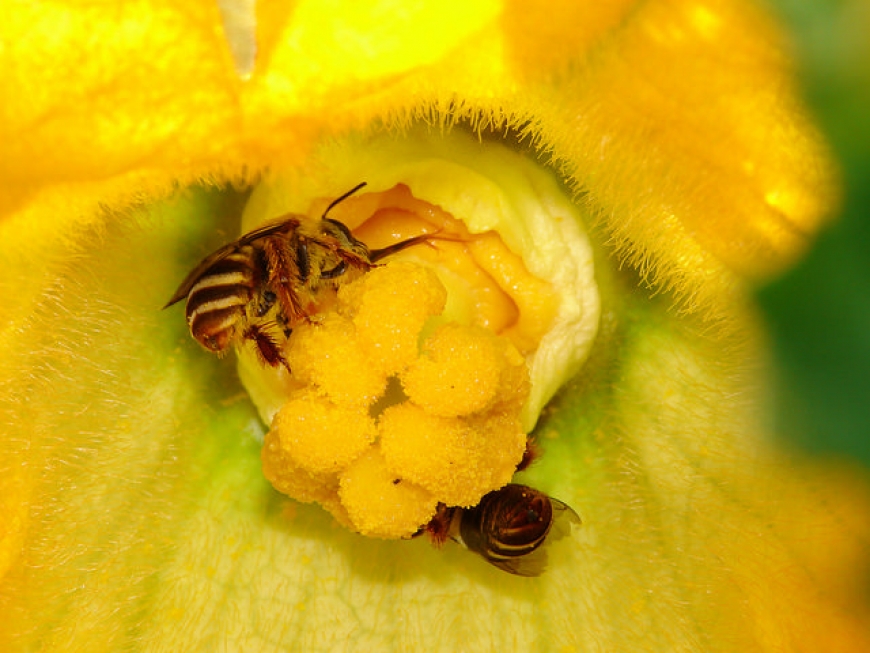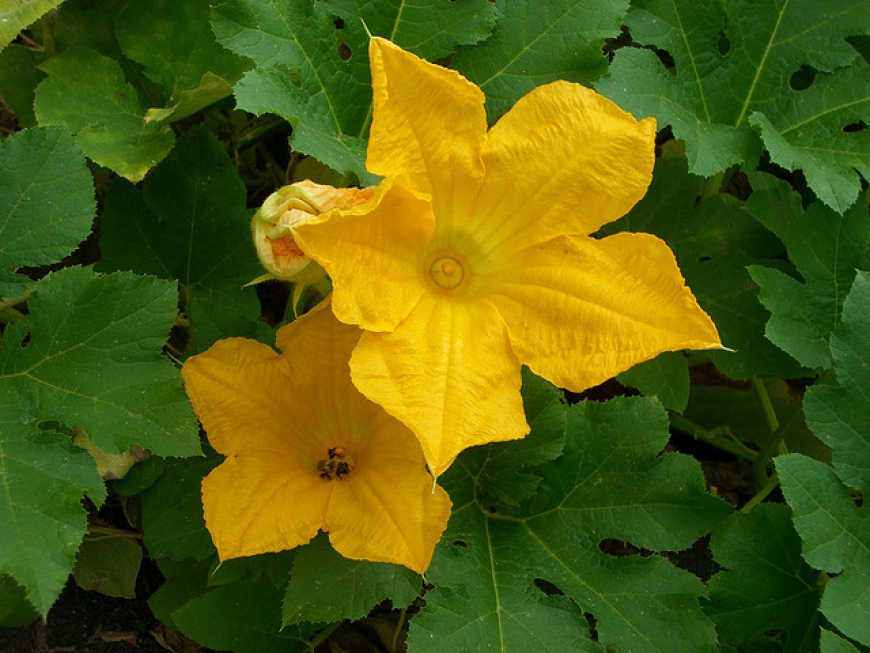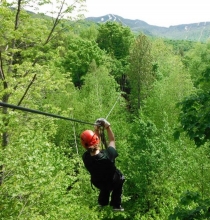

Peponapis bees pollinating a squash plant. Photo: USDA, Creative Commons.
Pumpkin flowers. Photo: Aaron Gustafson, Creative Commons.


Pumpkin Patch Pollinators
With the colder weather, the changing colors of the soon-to-be-orphaned tree leaves, and the emergence of Halloween decorations throughout the North Country, it is safe to say that fall has officially arrived. As we turn up our thermostats and begrudgingly get out our winter clothes (did we really ever stash them away?), we can look forward to indulging in such autumnal delicacies as pumpkin spice lattes, warm apple cider, pumpkin pie, and butternut squash soup. However, let us not forget to give thanks to those small, overlooked, and often under-appreciated creatures that make such treats possible—the bees.
Specifically, when it comes to the pollination of plants in the Cucurbita genus—including zucchini, squash, pumpkins, and gourds—there are two genera of bees we need to be particularly thankful for: Peponapis and Xenoglossa. These bees, commonly referred to as “squash bees” are pollen specialists on Cucurbits, meaning they have evolved a specific relationship with these plants, foraging for pollen exclusively from zucchini, squash, pumpkins, and gourds.
Cucurbits are characterized by the presence of tendrils, having large, rough, toothed leaves, and by their tubular flowers that are orange or yellow in color. The Cucurbita genus consists of nearly 24 different species of herbaceous vine plants, the majority of which are annuals. Cucurbits are also characterized as being monoecious—meaning they have both male and female flowers present on a single plant. In order for fruit to develop, the female flowers of Cucurbits need to be pollinated, making them reliant on bee pollinators to move pollen from male to female flowers.
Cucurbit flowers open in the morning and close after several hours—limiting the amount of time available for pollination. Thus, the squash bees are early risers and begin to pollinate Cucurbit blossoms as soon as they open in the morning. The bees themselves are native, solitary species that usually emerge in mid-to-late summer, nest in the ground, and are about half an inch in length. Both male and female squash bees are golden brown in color with yellow, fuzzy middles. Additionally, males have a yellow spot on their face.
Before honey bees (Apis mellifera) were introduced from Europe, squash bees were essential in facilitating the production, domestication, and spread of squash and gourd plants throughout the Americas. Studies suggest that Peponapis and Xenoglossa bees are more effective in pollinating Cucurbits, and therefore, if their populations flourish, they may render the common practice of renting colonies of honey bees to pollinate Cucurbit crops unnecessary. Like most bees, certain species of squash bees have been declining in numbers due to habitat degradation and pesticide use. Leaving bare patches of soil and avoiding laying down thick layers of mulch can help provide vital nesting habitat for these and other species of bees.
These bees time their emergence to coincide with the flowering of Cucurbits and typically live for only two months, when the squash and gourd plants are in flower. Two to three weeks after they emerge, female squash bees begin constructing their ground nests, tunneling one foot beneath the surface where they then lay their fertilized eggs and provision the nest with pollen collected exclusively from Cucurbits. The larvae of these species overwinter in their ground nests and emerge mid-to-late summer to begin the process anew.
So this fall, when you pass a particularly well-carved Jack O’ Lantern, indulge in a rich and hearty bowl of squash soup, or serve up a fresh pumpkin pie, try to remember the tiny bees that made it all possible in the first place: squash bees—our pumpkin patch pollinators.


This is so informative and I often wonder who did all the hard work (and who might continue to) with declines in honey bee populations. Thanks for informing us!
I'll say a word of thanks to the bees with my next slice of pie!